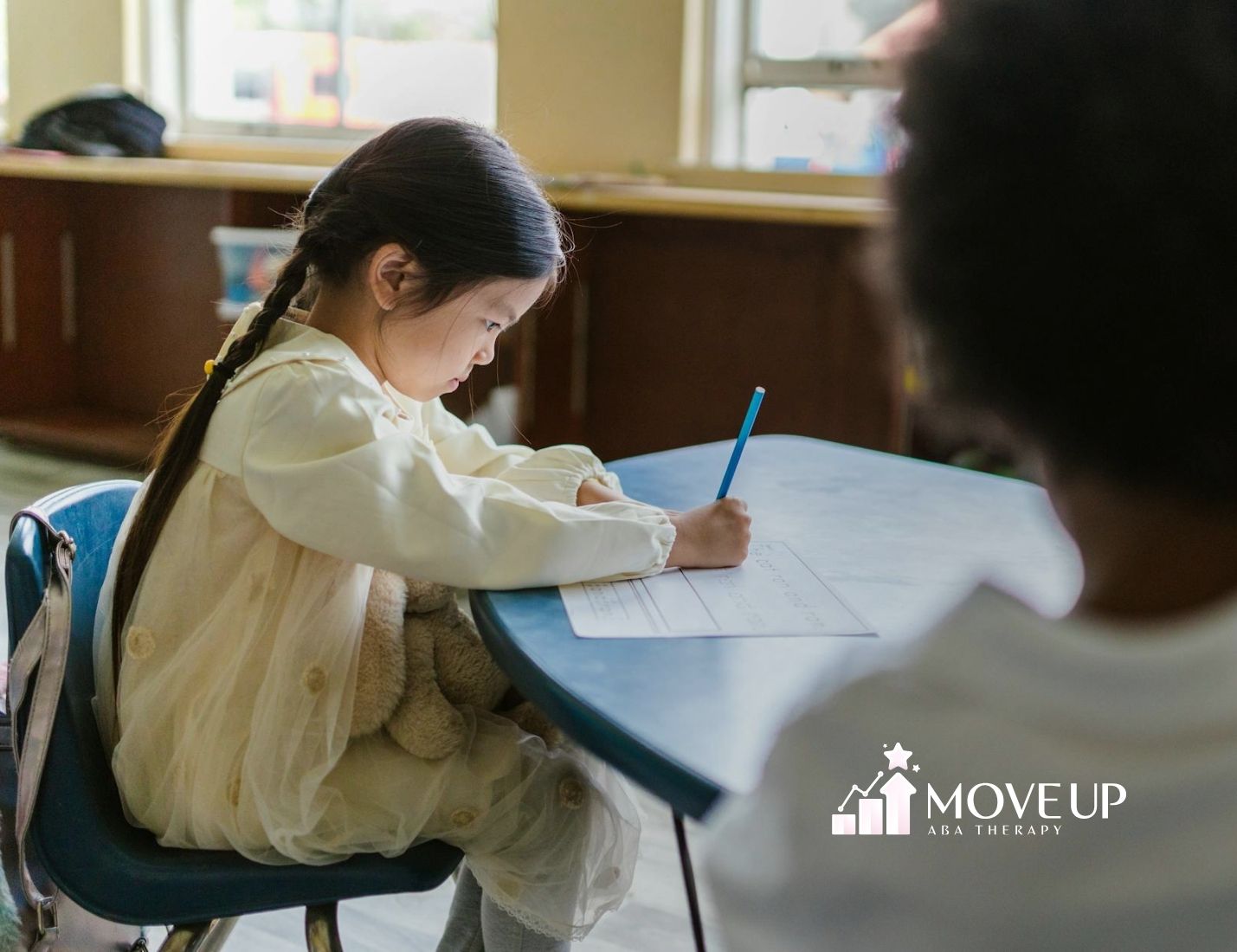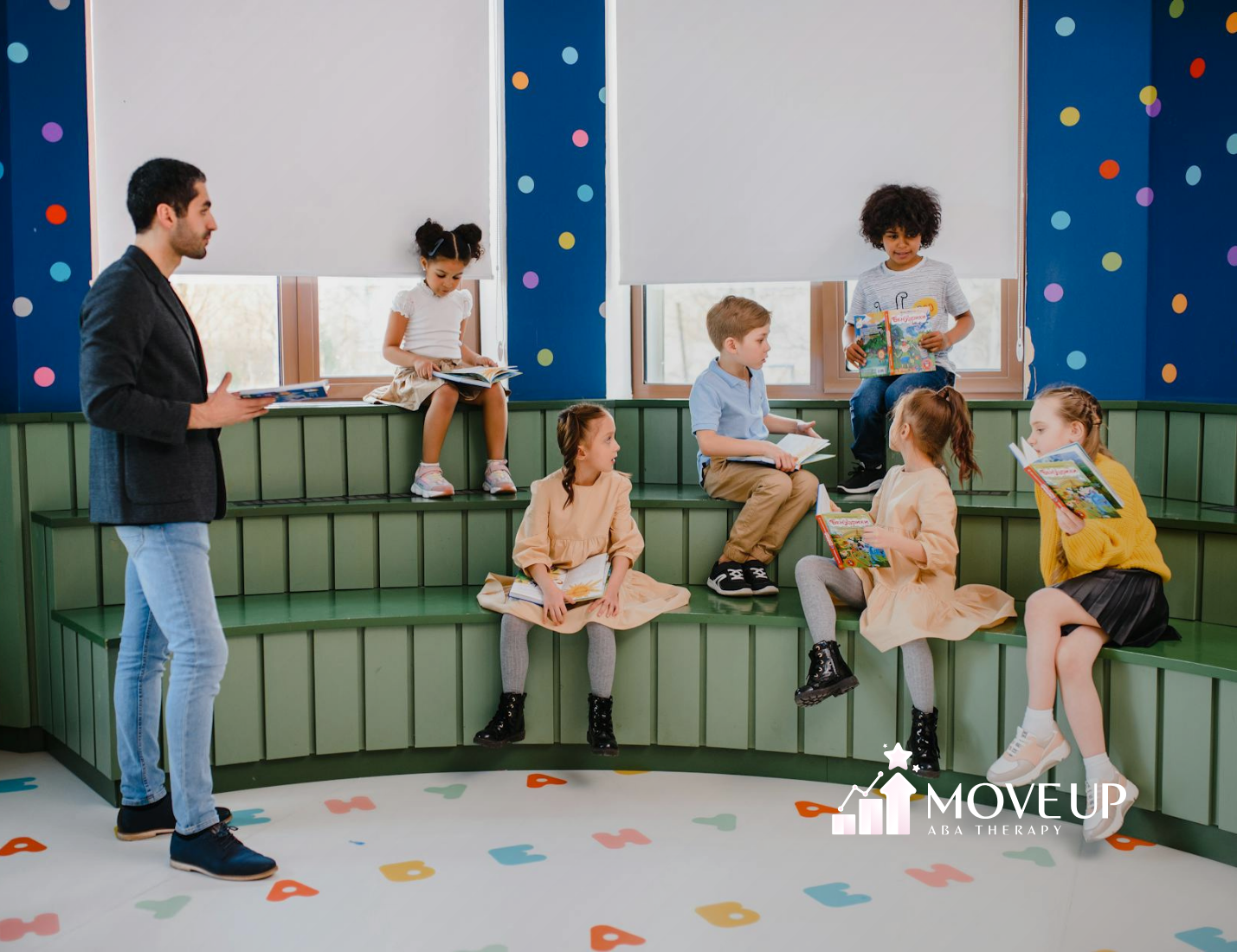Importance of School-Based ABA
Applied Behavior Analysis (ABA) therapy has emerged as a pivotal approach in educational settings, offering targeted strategies to support students with special needs, particularly those on the autism spectrum. This section will explore the benefits of school-based ABA for students and its impact on academic performance.
Benefits for Students
School-based ABA therapy provides numerous advantages for students with autism spectrum disorder (ASD) and related conditions. ABA techniques can be utilized in classrooms to foster speech, language development, and appropriate behaviors. Here are some key benefits:
- Enhanced Social Skills: ABA helps students develop essential social skills, enabling better interaction with peers.
- Improved Communication: Techniques such as Discrete Trial Training (DTT) and Natural Environment Teaching (NET) support language acquisition.
- Positive Behavior Changes: By reinforcing positive behaviors and reducing problematic ones, ABA creates a conducive learning environment.
- Increased Independence: Individualized strategies like Functional Behavior Assessment (FBA) and Behavior Intervention Plan (BIP) promote autonomy in students.
For further details on the interventions used, visit our school-based behavior therapy page.
Impact on Academic Performance
School-based ABA has a significant impact on academic performance. Implementing ABA techniques can lead to:
- Better Grades: Structured learning and individualized support strategies help students grasp academic concepts more effectively.
- Higher Engagement Levels: ABA encourages active participation in classroom activities.
- Reduced Disruptions: By addressing challenging behaviors, ABA minimizes disruptions, benefiting the entire classroom.
- Greater Access to Curriculum: Tailored interventions ensure that students with special needs can access and benefit from the standard curriculum.
To understand how these techniques are practically applied, check out our resources on ABA therapy in schools and specific school-based ABA interventions.
The following table highlights how different ABA techniques address various academic and behavioral aspects:
| ABA Technique | Focus Area | Impact |
| Discrete Trial Training (DTT) | Skill Acquisition | Enhanced understanding of academic concepts |
| Natural Environment Teaching (NET) | Real-World Application | Improved generalization of skills |
| Functional Behavior Assessment (FBA) | Behavior Analysis | Identifies root causes of behaviors |
| Behavior Intervention Plan (BIP) | Personalized Interventions | Reduces disruptive behaviors |
Applied Behavior Analysis in schools aims to develop communication skills, boost self-confidence, and improve behavioral management. These enhancements make significant strides in enhancing students’ educational journeys. For more detailed information on how ABA techniques support students, refer to our article on school-based autism therapy.
Effective ABA Techniques in Schools
In school settings, Applied Behavior Analysis (ABA) therapy employs several effective techniques to enhance the educational experiences and developmental outcomes of students with Autism Spectrum Disorder (ASD) and other related conditions. Here, we delve into two prominent strategies: Discrete Trial Training (DTT) and Natural Environment Teaching (NET).
Discrete Trial Training (DTT)
Discrete Trial Training (DTT) is a structured ABA technique focusing on breaking down skills into small, teachable components. Each component is taught in a “trial,” which consists of a specific set of instructions, a prompt, a learner’s response, and immediate feedback.
Key Elements of DTT:
- Instruction: The educator or therapist presents a clear and concise instruction.
- Prompt: Depending on the student’s needs, a prompt may be provided to aid the correct response.
- Response: The student responds to the instruction.
- Feedback: Immediate reinforcement or corrective feedback is given based on the student’s response.
Benefits of DTT:
- Enhances focus on specific skills.
- Provides clear, measurable progress.
- Useful for teaching new skills systematically.
| Component | Description |
| Instruction | Clear and concise direction |
| Prompt | Assistance to correct response |
| Response | Student’s action |
| Feedback | Immediate reinforcement |
Natural Environment Teaching (NET)
Natural Environment Teaching (NET) is an ABA technique that focuses on teaching skills during naturally occurring activities in the student’s everyday environment. This approach makes learning more functional and generalizable.
Key Elements of NET:
- Natural Settings: Teaching occurs in settings where the student naturally spends time.
- Student-Directed: The student’s interests and activities guide the learning process.
- Generalization: Skills learned are more likely to be applied in various real-life situations.
- Reinforcement: Naturally occurring rewards are used to reinforce desired behaviors.
Benefits of NET:
- Increases the likelihood of skill generalization.
- Engages the student in a more meaningful way.
- Encourages spontaneous learning and application of skills.
| Strategy | Description |
| Natural Settings | Learning in naturally occurring spaces |
| Student-Directed | Guided by the student’s interests |
| Generalization | Skills applied in various real-life situations |
| Reinforcement | Natural rewards for desired behaviors |
These specialized techniques, Discrete Trial Training and Natural Environment Teaching, offer structured learning opportunities tailored to individual students’ needs, promoting both academic and social skill development.
Individualized Support Strategies
To effectively implement ABA therapy in classrooms, it’s essential to focus on individualized support strategies for students with autism spectrum disorder (ASD). Two key approaches within this framework are Functional Behavior Assessment (FBA) and Behavior Intervention Plan (BIP).
Functional Behavior Assessment (FBA)
A Functional Behavior Assessment (FBA) is a critical tool used in school-based ABA therapy to understand why challenging behaviors occur. An FBA involves collecting data on the student’s behavior, identifying the antecedents and consequences, and determining the function or purpose of the behavior.
Conducting an FBA allows educators and therapists to develop targeted strategies that address the root cause of the challenging behavior, making the response more effective. This approach helps to ensure a positive learning environment for the student.
| Step | Description |
| Data Collection | Gather information on the behavior through observations, interviews, and behavior checklists. |
| Identify Antecedents | Determine what happens before the behavior occurs. |
| Identify Consequences | Determine what happens after the behavior occurs. |
| Determine Function | Understand why the behavior is occurring, such as to gain attention, escape a task, or access a tangible item. |
FBAs provide the foundation for creating comprehensive Behavior Intervention Plans, tailored to meet the specific needs of each student.
Behavior Intervention Plan (BIP)
Once an FBA is completed, a Behavior Intervention Plan (BIP) can be developed. A BIP outlines specific strategies and interventions aimed at reducing challenging behaviors and promoting positive behaviors. The plan is tailored to the student’s unique needs and includes detailed instructions for implementation by educators and school staff.
A BIP typically includes the following components:
- Replacement Behaviors: Identification of positive behaviors to be taught as alternatives to challenging behaviors.
- Preventive Strategies: Techniques to prevent the occurrence of challenging behaviors by addressing antecedents.
- Consequences: Specific responses to both challenging and positive behaviors.
- Data Collection: Ongoing monitoring and assessment of the student’s progress.
| Component | Description |
| Replacement Behaviors | Teaching positive alternatives to challenging behaviors. |
| Preventive Strategies | Techniques to prevent challenging behaviors. |
| Consequences | Responses to both challenging and positive behaviors. |
| Data Collection | Monitoring and assessment of progress. |
The implementation of a BIP involves collaboration between ABA therapists, educators, and school staff to ensure consistency and effectiveness. Parental involvement is also crucial for reinforcing the strategies at home and ensuring the overall success of the intervention.
These individualized strategies, when effectively implemented, contribute significantly to the success of school-based ABA interventions. They help create a supportive environment, allowing students with ASD to thrive academically and socially.
Building Trust and Rapport
Developing trust and rapport with students is foundational in achieving success with school-based ABA techniques. Establishing strong, positive relationships is critical in promoting a conducive learning environment and ensuring effective ABA interventions.
Significance of Positive Interaction
Positive interaction is a cornerstone of Applied Behavior Analysis (ABA). This involves engaging students in activities that foster connection and build trust. Activities that promote bonding and trust significantly enhance the learning experience. Positive interaction includes verbal affirmations, attentive listening, and empathetic communication.
| Positive Interaction Techniques | Description |
| Verbal Affirmations | Regularly acknowledging and affirming positive behaviors and efforts. |
| Attentive Listening | Paying close attention to students’ needs and responding empathetically. |
| Empathetic Communication | Using understanding and compassion in all interactions. |
Positive interaction encourages students to feel valued and understood, which is essential for motivation and engagement in the learning process.
Utilizing Praise and Rewards
Praise and rewards play a crucial role in ABA therapy, particularly in school settings. Positive reinforcement is a primary strategy within ABA, where students receive rewards for demonstrating specific behaviors or skills effectively. This technique not only encourages repetition of the desired behavior but also enhances the student’s self-esteem and confidence.
According to Autism Speaks, rewards can vary widely, from verbal praise to access to preferred items or activities. This flexibility allows for personalization based on what is most motivating for each student.
| Type of Reward | Examples |
| Verbal Praise | “Great job!”, “Well done!” |
| Tangible Rewards | Stickers, toys, certificates |
| Activity Rewards | Extra playtime, favorite games, special privileges |
Using a combination of praise and rewards can significantly impact behavior positively. It is important for educators and therapists to collaborate closely to ensure the reinforcement strategies align with each student’s needs and preferences.
By incorporating these strategies, educators and ABA professionals can create a supportive and encouraging learning environment, fostering both academic and social development. Continuous collaboration among ABA therapists, educators, and parents ensures cohesive and effective implementation of these techniques, benefiting students with autism and related conditions.
Targeted Strategies for ASD
Targeted strategies in school-based ABA therapy are essential for supporting students with Autism Spectrum Disorder (ASD). These strategies focus on addressing communication difficulties and enhancing social skills.
Addressing Communication Difficulties
Communication is a key area where students with ASD often require additional support. ABA therapy addresses these difficulties through a variety of methods.
- Picture Exchange Communication System (PECS): PECS allows students to communicate using pictures. This method can be particularly effective for non-verbal students or those with limited verbal skills.
- Sign Language: Teaching basic sign language can provide a non-verbal mode of communication, helping to bridge the gap for students who struggle with spoken language.
- Speech Therapy Integration: Combining speech therapy with ABA techniques can enhance communication skills. Speech therapists work alongside ABA therapists to create a comprehensive intervention plan.
- Use of Technology: Tablets and communication apps can be highly effective tools. These devices offer interactive ways to practice and improve communication skills.
- Reinforcement of Verbal Attempts: Positive reinforcement is used to encourage verbal attempts. Every effort to communicate is met with praise or a reward, fostering a supportive learning environment.
Enhancing Social Skills
Social skills are another critical area of focus in school-based ABA therapy. Improving these skills helps students with ASD interact more effectively with peers and adults.
- Social Stories: These are short stories that describe social situations and appropriate responses. They help students understand social cues and develop appropriate behaviors.
- Group Activities: Structured group activities encourage interaction and collaboration. These activities can include games, projects, or group discussions.
- Role-Playing: Role-playing different social scenarios teaches students how to navigate various social interactions. Practicing these scenarios in a safe environment builds confidence and skill.
- Peer Modeling: Observing and imitating peers can be a powerful learning tool. Peer modeling involves pairing students with ASD with typically developing peers who demonstrate proper social behavior.
- Social Skills Training Programs: These programs use structured lessons to teach specific social skills. Topics might include making friends, sharing, taking turns, and understanding non-verbal cues.
Below is a table summarizing the targeted strategies for communication and social skills:
| Area | Strategy | Description |
| Communication | Picture Exchange Communication System (PECS) | Uses pictures for communication |
| Communication | Sign Language | Offers a non-verbal communication method |
| Communication | Speech Therapy Integration | Combines speech and ABA therapy |
| Communication | Use of Technology | Tablets and apps for interactive learning |
| Communication | Reinforcement of Verbal Attempts | Positive reinforcement for verbal efforts |
| Social Skills | Social Stories | Stories describing social scenarios |
| Social Skills | Group Activities | Encourages interaction through shared activities |
| Social Skills | Role-Playing | Practicing social scenarios |
| Social Skills | Peer Modeling | Learning through observing peers |
| Social Skills | Social Skills Training Programs | Structured lessons on social behavior |
Collaboration in School-Based ABA
Effective collaboration is vital for the success of school-based ABA interventions. ABA therapy involves the collective efforts of various stakeholders including educators, school staff, behavior analysts (BCBAs), and registered behavior technicians (RBTs) to create an inclusive learning environment.
Involvement of Educators and School Staff
Educators and school staff are essential in implementing ABA techniques successfully in the school environment. Their participation ensures that the strategies align with educational goals and classroom dynamics. Collaboration among teachers, behavior analysts, therapists, and parents plays a crucial role in tailoring individualized education plans (IEPs) and evidence-based interventions for students with autism spectrum disorder (ASD).
Key roles of educators and school staff in school-based ABA:
- Alignment of Goals: Participation in setting educational and developmental goals.
- Consistent Implementation: Ensuring ABA strategies are correctly applied during classroom activities.
- Ongoing Training: Attending workshops and training sessions to understand and implement ABA techniques effectively.
- Data Collection: Monitoring and recording student progress to assist in adapting and optimizing interventions.
Role of BCBAs and RBTs
Board Certified Behavior Analysts (BCBAs) and Registered Behavior Technicians (RBTs) are pivotal in crafting and executing ABA programs within the school context. They bring expertise in behavior analysis, helping to dissect and address the unique needs of each student with autism.
Board Certified Behavior Analysts (BCBAs):
- Program Design: Customize ABA programs based on individual student needs, skills, interests, and preferences.
- Goal Setting: Develop specific, measurable, and attainable treatment goals tailored to the student’s age and ability level.
- Training and Supervision: Educate and mentor educators and school staff on ABA techniques to ensure consistency and effectiveness.
Registered Behavior Technicians (RBTs):
- Direct Implementation: Conduct one-on-one ABA sessions with students, following the guidance and protocols set by the BCBA.
- Progress Monitoring: Collect data on student performance and progress, providing crucial information for adjusting interventions.
- Skill Acquisition: Utilize positive reinforcement strategies and other ABA techniques to encourage and teach new skills.
| Role | Responsibilities |
| Educators | Align goals, implement strategies, ongoing training, data collection |
| BCBAs | Program design, goal setting, training and supervision |
| RBTs | Direct implementation, progress monitoring, skill acquisition |
A successful school-based ABA program necessitates collaboration among all parties involved. This partnership enhances the effectiveness of interventions, ensuring a comprehensive approach that addresses both academic and social skills for students with autism spectrum disorder.
SOURCES:
https://pmc.ncbi.nlm.nih.gov/articles/PMC7265021/
https://www.autismspeaks.org/applied-behavior-analysis
https://ensorahealth.com/blog/how-bcbas-can-best-collaborate-with-teachers/
https://pmc.ncbi.nlm.nih.gov/articles/PMC9788712/
https://www.appliedbehavioranalysisedu.org/2021/11/aba-in-classroom/
https://asatonline.org/for-parents/learn-more-about-specific-treatments/applied-behavior-analysis-aba/aba-techniques/







